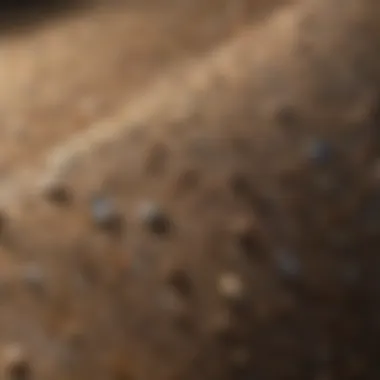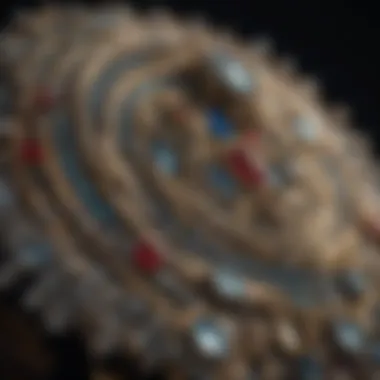Discover the Top Glue for Precisely Attaching Rhinestones to Fabric


This segment will delve into the complexities involved in selecting the most appropriate adhesive for bonding rhinestones on fabric. Our discussion will encompass various glue varieties, their adhesive attributes, and application techniques to ensure a steadfast and enduring attachment between rhinestones and fabric. Let's embark on a journey to unravel the intricacies of achieving a flawless and long-lasting embellishment!
Introduction
In the realm of artistic embellishment, the process of attaching rhinestones to fabric stands as a quintessential craft that requires precision, patience, and the right adhesive. This article will serve as a guiding beacon through the intricate maze of selecting the perfect glue to affix rhinestones onto various fabric types. Delving deep into the nuanced world of adhesive selection, we will uncover the key criteria, considerations, and nuances that play a pivotal role in ensuring a durable and aesthetically pleasing bond between these shimmering gems and fabric substrates.
Embarking on this journey, we will unravel the distinctive characteristics of different types of rhinestones and explore the diverse landscape of fabric compositions. Understanding the material composition of rhinestones is crucial as it impacts the choice of adhesive, ensuring compatibility and longevity of the bond. Similarly, dissecting the intricate nuances of various fabric types, with their unique textures and porosities, paves the way for informed glue selection, a pivotal step in the meticulous process of embellishing fabrics with rhinestones.
The gravity of selecting the ideal glue is underscored by a myriad of factors that influence the adhesive prowess on this creative endeavor. From the type of rhinestone being utilized to the fabric's porosity and texture, each element plays a pivotal role in determining the efficacy and longevity of the bond. Furthermore, considerations surrounding the desired durability and wash resistance of the final product shed light on the importance of meticulous glue selection, underscoring the significance of selecting the perfect adhesive for this embellishment process.
As we navigate through the uncharted waters of glue selection for rhinestones on fabric, our compass will guide us through various types of adhesives. From the reliable fabric glue to the specialized Gem-Tac adhesive and the industrial-strength E6000 adhesive, we will unravel the distinctive properties and applications of each glue type. Additionally, the enigmatic realm of Hot Fix adhesive will be explored, offering insights into its unique approach to ensuring a secure bond between rhinestones and fabric surfaces.
Rest assured, dear reader, as we advance through this comprehensive guide, the application techniques for attaching rhinestones will be unveiled. From the meticulous preparation of fabric and rhinestones to the precise application and strategic placement of each gem, we will unravel the intricate steps necessary for creating a visually stunning and enduring bond. Moreover, the drying and curing process post-application, alongside post-care guidelines and maintenance tips, will ensure that your rhinestone-adorned fabric creations stand the test of time.
Understanding Rhinestones and Fabric Composition
In this meticulous exploration of the best glues for attaching rhinestones to fabric, understanding the intricacies of rhinestone and fabric composition forms the foundation of a successful bonding process. By comprehensively grasping the characteristics and properties of both rhinestones and fabrics, one can make informed decisions regarding the choice of glue. This section serves as a crucial starting point for enthusiasts and artisans looking to create durable and visually appealing rhinestone designs on fabric.
Material Composition of Rhinestones
Delving into the material composition of rhinestones reveals the diverse nature of these sparkling gems. Rhinestones can be crafted from various materials such as glass, crystal, acrylic, or even gemstones like quartz or cubic zirconia. Each material brings its unique luster, clarity, and durability to the table, impacting both the aesthetic appeal and the adhesive requirements for bonding them to fabric. Understanding these distinctions empowers individuals to select the most compatible glue for their specific rhinestone type, ensuring a secure and long-lasting attachment.
Characteristics of Different Fabric Types


Similarly, exploring the characteristics of different fabric types sheds light on the varying textures, porosities, and compositions that influence the adhesion process. Fabrics range from delicate silks to sturdy denims, each demanding a tailored approach when it comes to attaching rhinestones. Factors such as weave tightness, synthetic blends, and surface smoothness play a critical role in determining the effectiveness of the chosen adhesive. By considering these fabric-specific attributes, crafters can optimize their glue selection to create embellished pieces that withstand wear and tear while maintaining their exquisite allure.
Factors Influencing Glue Selection
In the realm of attaching rhinestones to fabric, the selection of an appropriate glue holds paramount importance. The efficacy of this process is heavily reliant on the adhesive properties and characteristics of the chosen glue. Understanding the factors influencing glue selection can significantly impact the final outcome of the embellishment. One of the key aspects to consider is the type of rhinestone being used. Different rhinestones may necessitate specific types of adhesives to ensure a secure bond. Additionally, the fabric's porosity and texture play a crucial role in determining the optimal adhesive choice. Fabrics with varying textures or levels of porosity may require different glues to achieve a lasting attachment. Moreover, the desired durability and wash resistance of the rhinestone embellishment are essential factors to consider when selecting a glue. For long-lasting results, choosing a glue that can withstand multiple washes and maintain its adhesive properties over time is paramount.
Type of Rhinestone
When considering the type of rhinestone to attach to fabric, it is imperative to assess the material composition and surface characteristics of the rhinestone. Some rhinestones may have smooth surfaces that adhere well with certain adhesives, while others with irregular textures may require stronger bonding agents. The type of rhinestone being used dictates the adhesive properties needed in the glue for a reliable and enduring attachment. Understanding the intricacies of different rhinestone varieties is crucial in selecting the most suitable glue for the specific type being utilized.
Fabric Porosity and Texture
Fabric porosity and texture significantly influence the choice of glue for attaching rhinestones. Fabrics with porous surfaces may require adhesives that can penetrate and grip the fibers effectively to create a secure bond. Similarly, different fabric textures may interact differently with the glue, impacting the adhesion strength and longevity of the bond. Considering the porosity and texture of the fabric is essential in ensuring the rhinestones remain firmly attached without the risk of detachment or damage.
Desired Durability and Wash Resistance
The desired durability and wash resistance of the rhinestone-adorned fabric dictate the type of glue needed for a lasting bond. If the fabric embellishment will be subjected to frequent washing or wear, opting for a glue specifically formulated for wash resistance is crucial. The durability of the adhesive determines how well it can withstand repeated laundering without losing its adhesive properties. Choosing a glue that offers both durability and wash resistance ensures that the rhinestones remain securely affixed to the fabric for an extended period, maintaining their sparkle and allure.
Types of Glue Suitable for Rhinestones on Fabric
In the realm of attaching rhinestones to fabric, the selection of the appropriate glue is of utmost significance. It is a critical factor that determines the longevity and security of the bond between the dazzling embellishments and the fabric surface. Various types of glue offer distinct features and benefits, each catering to different requirements and scenarios. Understanding the characteristics and applications of these glues is essential to achieve optimal results in the adornment process.
Fabric Glue
Fabric glue stands out as a versatile option for securing rhinestones onto fabric. Specifically formulated for fabric materials, this adhesive offers a strong and durable bond that withstands regular wear and tear. Its flexibility ensures that the fabric maintains its natural drape and texture even after rhinestone attachment. Fabric glue is ideal for delicate fabrics, ensuring that they remain intact without any damage during the application process. This type of glue is suitable for beginners and professionals alike due to its ease of use and reliability in creating a lasting bond.


Gem-Tac Adhesive
Gem-Tac adhesive is renowned for its exceptional clarity and strength in adhering rhinestones to fabric surfaces. This specialized glue dries clear, leaving behind a flawless finish that enhances the sparkle of the rhinestones. Its quick-drying properties make it a preferred choice for projects requiring efficiency and precision. Gem-Tac adhesive provides a secure bond that remains intact even after multiple washes, making it ideal for garments and accessories that undergo frequent cleaning. Its versatility allows for the attachment of rhinestones on a wide range of fabric types, ensuring a seamless and professional result.
E6000 Adhesive
E6000 adhesive is a robust and reliable option for attaching rhinestones to fabric with long-lasting durability. Known for its industrial-strength formula, this adhesive creates a resilient bond that withstands varied environmental conditions. The flexibility of E6000 adhesive allows fabrics to move naturally without compromising the bond with the rhinestones. Its heat-resistant properties make it suitable for projects that undergo heat exposure, ensuring that the embellishments remain secured in place. E6000 adhesive offers a permanent solution for attaching rhinestones, making it highly favored for intricate designs and detailed embellishments.
Hot Fix Adhesive
Hot fix adhesive presents a unique approach to attaching rhinestones to fabric through heat activation. This adhesive is applied in conjunction with a heat tool to melt the glue, creating a strong bond between the rhinestones and fabric. Hot fix adhesive is ideal for large-scale projects and intricate designs that require precise placement of rhinestones. Its quick-setting nature allows for efficient application, reducing the time needed for the embellishment process. Moreover, hot fix adhesive offers a secure bond that remains intact even with repeated washings, ensuring the longevity of the embellished fabric projects.
Application Techniques for Attaching Rhinestones
Application techniques play a crucial role in the process of affixing rhinestones to fabric, ensuring a secure and long-lasting bond. To achieve optimal results, it is essential to prepare the fabric and rhinestones meticulously before applying the glue. Understanding the properties of the fabric and the type of rhinestones being used is key in determining the most suitable adhesive and technique. Careful consideration of the fabric's porosity and texture helps in selecting the right glue that will adhere effectively. When applying the glue, precision and patience are paramount. A uniform layer of adhesive should be applied to the fabric, avoiding excess glue that can seep through. The placement and pressing of rhinestones onto the fabric should be done gently but firmly, ensuring they are securely attached. Additionally, adhering to proper drying and curing times is crucial to guarantee the longevity of the bond between the rhinestones and fabric. Overall, mastering the application techniques for attaching rhinestones is fundamental in achieving a flawless, professional-looking result.
Preparation of Fabric and Rhinestones
Before starting the attachment process, thorough preparation of both the fabric and rhinestones is vital. For the fabric, ensure it is clean and free from any dust or debris that can interfere with the adhesion of the glue. Consider the fabric's composition and texture to determine the best approach for applying the adhesive. Similarly, inspect the rhinestones for any imperfections or coatings that may affect the bond with the fabric. Cleaning the rhinestones with a gentle solution and allowing them to dry completely can optimize the adhesion process. Proper preparation sets the foundation for a successful application, enhancing the durability and appearance of the rhinestone embellishments.
Applying the Glue
The correct application of glue is a critical step in attaching rhinestones to fabric effectively. Depending on the type of glue used, follow the manufacturer's instructions for application to ensure a strong and durable bond. Use a small amount of glue to avoid excess that can seep out from under the rhinestone. Apply the adhesive evenly on the fabric, focusing on the areas where the rhinestones will be placed. Precise application is key to preventing any visible glue residue on the fabric once the rhinestones are attached. Working in small sections allows for better control and alignment of the rhinestones, resulting in a neater and more professional finish.
Placement and Pressing of Rhinestones


After applying the glue, carefully position the rhinestones on the fabric according to the desired design. Use tweezers or a rhinestone applicator for accuracy and to avoid getting excess adhesive on your fingers. Gently press down on each rhinestone to secure it in place, ensuring proper contact with the glue. Pay attention to the alignment and spacing of the rhinestones to create a uniform and visually appealing arrangement. Applying consistent pressure while pressing down helps to bond the rhinestones securely to the fabric. Allow sufficient time for the glue to set and cure according to the manufacturer's recommendations to ensure a strong and enduring attachment. By mastering the placement and pressing techniques, you can achieve professional-looking embellishments that elevate the aesthetic of your fabric creations.
Drying and Curing Process
In the intricate world of affixing rhinestones to fabric, the Drying and Curing Process holds a pivotal role in ensuring a secure and enduring bond between these dazzling embellishments and the fabric they adorn. As we explore this essential phase of the bonding process, several critical elements come into play, each contributing to the overall effectiveness and longevity of the attachment.
The fundamental significance of the Drying and Curing Process lies in its ability to solidify the adhesive properties of the chosen glue. This phase allows the glue to set and adhere firmly to both the rhinestone and the fabric, creating a robust connection that can withstand the test of time. Moreover, proper drying and curing prevent any premature detachment of the rhinestones, guaranteeing a flawless and lasting display of shimmer and style.
One must pay keen attention to the duration and conditions of the Drying and Curing Process to reap its maximum benefits. Depending on the type of glue used, the ambient temperature, and the humidity levels, the drying time may vary. It is imperative to follow the specific guidelines provided by the glue manufacturer to achieve optimal results. Moreover, allowing sufficient time for the glue to cure completely enhances its bond strength and durability, ensuring that your rhinestones stay put even with regular wear and tear.
Careful consideration of the fabric type and rhinestone size is also crucial during the Drying and Curing Process. Different fabrics and rhinestone materials may require varying drying times or curing methods to achieve the desired outcome. Additionally, factors like air circulation and exposure to light can influence the drying process, warranting a controlled environment for the best results.
Post-Application Care and Maintenance
After successfully attaching rhinestones to fabric using the chosen adhesive, the essential aspect of post-application care and maintenance plays a vital role in ensuring the longevity and durability of your creation. This section focuses on the meticulous care required to preserve the embellishments and fabric's integrity over time.
Cleaning Guidelines
Proper cleaning techniques are paramount in maintaining the spark and shine of rhinestones on fabric. Incorporating gentle methods such as handwashing with mild detergent, avoiding harsh chemicals or rough scrubbing, and allowing the fabric to air dry can help retain the rhinestones' luster. Regular inspection for any loosened stones and addressing them promptly is key to preventing further damage.
Storage Recommendations
Effective storage practices are crucial for safeguarding the embellished fabric when not in use. Opt for storing the item in a cool, dry place away from direct sunlight to prevent discoloration or adhesive weakening. Utilizing tissue paper or soft fabric to cover the rhinestones can prevent abrasion and ensure they remain securely attached. Additionally, consider storing the item flat or rolled to maintain the fabric's shape and prevent any undue stress on the rhinestone attachments.
Conclusion
One of the key points highlighted in this article is the significance of understanding the various types of glue available for attaching rhinestones to fabric. By comprehensively exploring options such as fabric glue, Gem-Tac adhesive, E6000 adhesive, and hot fix adhesive, readers are equipped with the knowledge to make informed decisions based on their project requirements. This information empowers individuals to select the most suitable adhesive for their specific fabric and rhinestone combination.
Additionally, the discussion on adhesive properties and application methods sheds light on the critical aspects that contribute to a secure and enduring bond between rhinestones and fabric. Understanding the factors influencing glue selection, such as the type of rhinestone, fabric porosity and texture, as well as desired durability and wash resistance, is paramount in achieving a successful outcome in any rhinestone application project.
Moreover, the conclusion serves to emphasize the meticulous application techniques for attaching rhinestones, including the preparation of fabric and rhinestones, applying the glue effectively, and ensuring proper placement and pressing for a lasting bond. By adhering to these precise application instructions, individuals can enhance the longevity and durability of their rhinestone-adorned creations.







